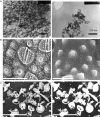Silica in plants: biological, biochemical and chemical studies
- PMID: 17921489
- PMCID: PMC2759229
- DOI: 10.1093/aob/mcm247
Silica in plants: biological, biochemical and chemical studies
Abstract
Background: The incorporation of silica within the plant cell wall has been well documented by botanists and materials scientists; however, the means by which plants are able to transport silicon and control its polymerization, together with the roles of silica in situ, are not fully understood.
Recent progress: Recent studies into the mechanisms by which silicification proceeds have identified the following: an energy-dependent Si transporter; Si as a biologically active element triggering natural defence mechanisms; and the means by which abiotic toxicities are alleviated by silica. A full understanding of silica formation in vivo still requires an elucidation of the role played by the environment in which silica formation occurs. Results from in-vitro studies of the effects of cell-wall components associated with polymerized silica on mineral formation illustrate the interactions occurring between the biomolecules and silica, and the effects their presence has on the mineralized structures so formed.
Scope: This Botanical Briefing describes the uptake, storage and function of Si, and discusses the role biomolecules play when incorporated into model systems of silica polymerization as well as future directions for research in this field.
Figures


Similar articles
-
Silica deposition in plants: scaffolding the mineralization.Ann Bot. 2023 Jul 10;131(6):897-908. doi: 10.1093/aob/mcad056. Ann Bot. 2023. PMID: 37094329 Free PMC article. Review.
-
Biosilicification: the role of the organic matrix in structure control.J Biol Inorg Chem. 2000 Oct;5(5):537-50. doi: 10.1007/s007750000130. J Biol Inorg Chem. 2000. PMID: 11085644 Review.
-
Silicification process in diatom algae using different silicon chemical sources: Colloidal silicic acid interactions at cell surface.Colloids Surf B Biointerfaces. 2018 Jan 1;161:620-627. doi: 10.1016/j.colsurfb.2017.11.032. Epub 2017 Nov 14. Colloids Surf B Biointerfaces. 2018. PMID: 29156339
-
Is callose required for silicification in plants?Biol Lett. 2018 Oct 3;14(10):20180338. doi: 10.1098/rsbl.2018.0338. Biol Lett. 2018. PMID: 30282746 Free PMC article. Review.
-
An overview of silica in biology: its chemistry and recent technological advances.Prog Mol Subcell Biol. 2009;47:295-313. doi: 10.1007/978-3-540-88552-8_13. Prog Mol Subcell Biol. 2009. PMID: 19198783
Cited by
-
Formation of root silica aggregates in sorghum is an active process of the endodermis.J Exp Bot. 2020 Dec 2;71(21):6807-6817. doi: 10.1093/jxb/erz387. J Exp Bot. 2020. PMID: 31504726 Free PMC article.
-
Is there silicon in flowers and what does it tell us?Ecol Evol. 2023 Oct 17;13(10):e10630. doi: 10.1002/ece3.10630. eCollection 2023 Oct. Ecol Evol. 2023. PMID: 37854315 Free PMC article.
-
Silicon Application Modulates Growth, Physio-Chemicals, and Antioxidants in Wheat (Triticum aestivum L.) Exposed to Different Cadmium Regimes.Dose Response. 2021 May 31;19(2):15593258211014646. doi: 10.1177/15593258211014646. eCollection 2021 Apr-Jun. Dose Response. 2021. PMID: 34158808 Free PMC article.
-
Alleviatory effects of Silicon on the morphology, physiology, and antioxidative mechanisms of wheat (Triticum aestivum L.) roots under cadmium stress in acidic nutrient solutions.Sci Rep. 2021 Jan 21;11(1):1958. doi: 10.1038/s41598-020-80808-x. Sci Rep. 2021. PMID: 33479268 Free PMC article.
-
A solution study of silica condensation and speciation with relevance to in vitro investigations of biosilicification.J Phys Chem B. 2010 Aug 12;114(31):9947-55. doi: 10.1021/jp101347q. J Phys Chem B. 2010. PMID: 20684617 Free PMC article.
References
-
- Bélanger RR, Benhamou N, Menzies JG. Cytological evidence of an active role of silicon in wheat resistance to powdery mildew (Blumeria graminis f. sp tritici) Phytopathology. 2003;93:402–412. - PubMed
-
- Belton D, Paine G, Patwardhan SV, Perry CC. Towards an understanding of (bio)silicification: the role of amino acids and lysine oligomers in silicification. Journal of Materials Chemistry. 2004;14:2231–2241.
-
- Belton D, Patwardhan SV, Perry CC. Putrescine homologues control silica morphogenesis by electrostatic interactions and the hydrophobic effect. Chemical Communications. 2005;27:3475–3477. - PubMed
-
- Belton DJ, Patwardhan SV, Perry CC. Spermine, spermidine and their analogues generate tailored silcas. Journal of Materials Chemistry. 2005;15:4629–4638.
-
- Casey WH, Kinrade SD, Knight CTG, Rains DW, Epstein E. Aqueous silicate complexes in wheat. Triticum aestivum L. Plant, Cell and Environment. 2003;27:49–52.
Publication types
MeSH terms
Substances
LinkOut - more resources
Full Text Sources
Other Literature Sources

